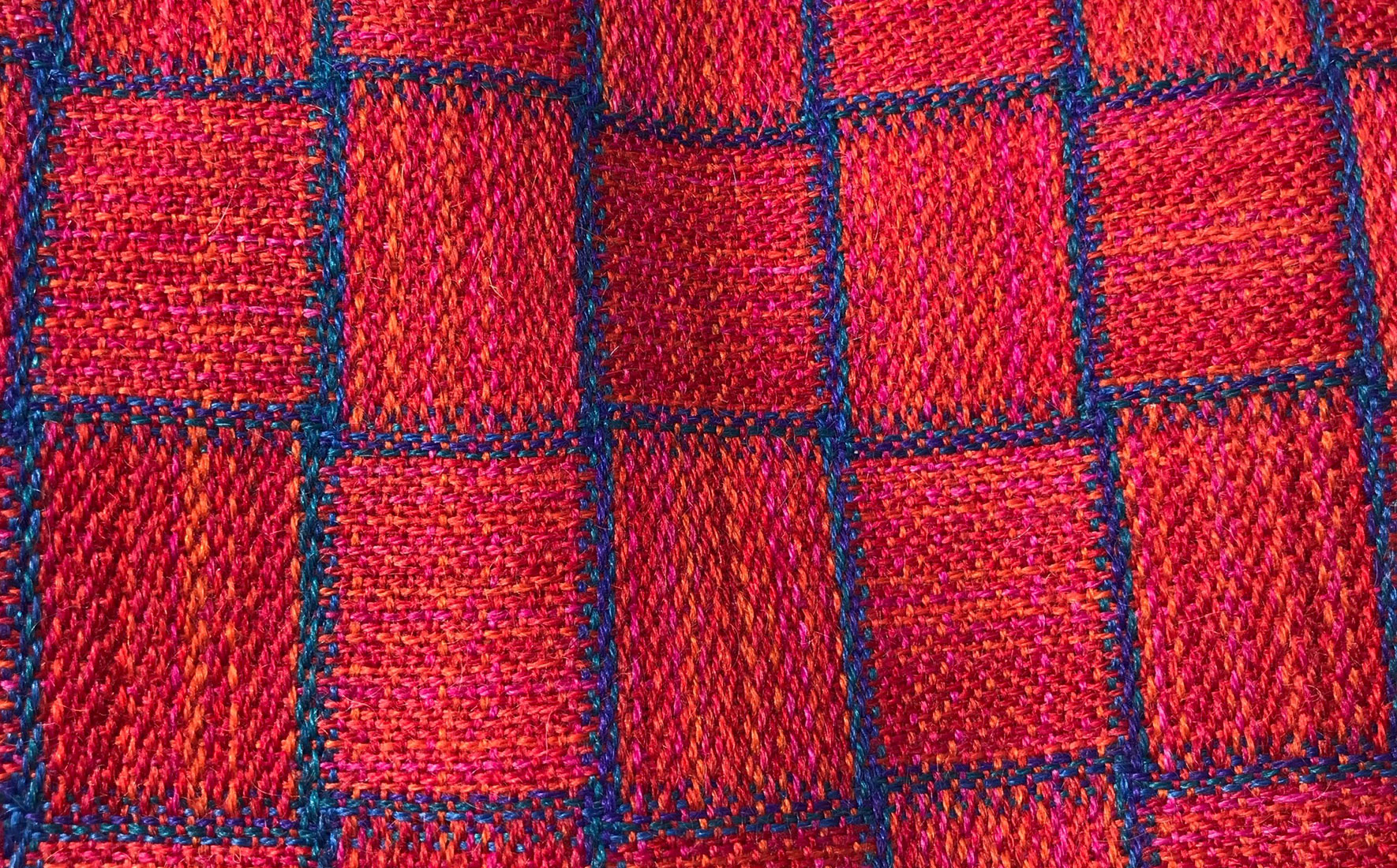
This episode features:
Ashley Gray, Director of Gray MCA – an expert in mid-century textiles and co-curator of the recent exhibition on Modern British Female Designers at Messums, Wiltshire. instagram.com/GrayMCA/
Alexis Shepherd, Clothes Designer and friend of Althea McNish’s.
Christine Checinska Curator of African and African Diaspora Fashion at the Victoria and Albert Museum. instagram.com/Checinskachristine/
Deep thanks to them all for their expertise and their time.

Althea as a young designer in London
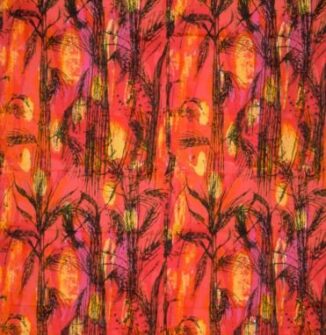
Her best selling design Golden Harvest, 1959
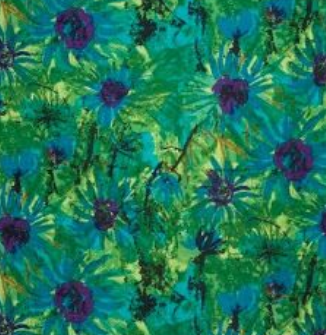
Title unknown

Bousada, 1958, fashion fabric for Liberty

Tepeaca, 1962, fashion fabric for Liberty
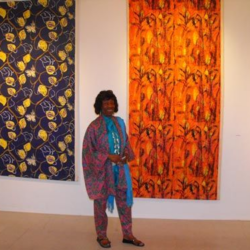
Althea in later life with some of her fabrics
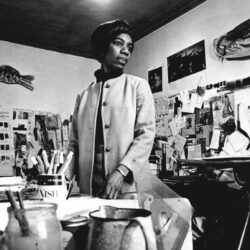
Althea McNish – at the height of her powers.
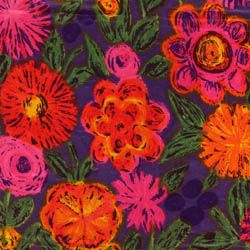
Grenada, 1960, fashion fabric, Liberty

Tropique, Ascher 1957
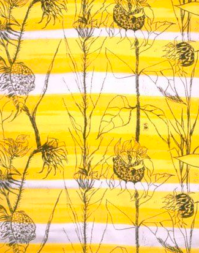
Van Gogh 1959
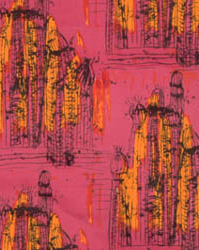
Painted Desert 1959
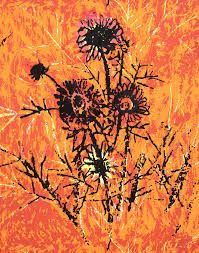
Rubra, 1961
Resources
If you would like to read more about Althea and her wonderful designs, here are some sources I found useful – but someone needs to write the book!
Althea and John’s own website is still online – I don’t know how much longer it will survive, but it has a lot of good information. http://mcnishandweiss.uk/
Material: Textile Modern British Female Designers, by Ashley Gray, Gray MCA and Hannah Hooks. Published by Messums, 2020.
Shirley Craven and Hull Traders, Revolutionary Fabrics and Furniture, 1957-1980, by Lesley Jackson, published by the Antique Collectors’ Club, 2009.
Women Design, Libby Sellers, published by Frances Lincoln and Quarto 2017.
The Guardian carried an obituary of Althea: https://www.theguardian.com/fashion/2020/may/04/althea-mcnish-obituary
Script
Colour is Mine
Welcome to Haptic and Hue’s first series of podcasts, which looks at textiles and cloth of all kinds down the centuries and thinks about the often, hidden hands that make them and the role they play in our lives. I’m Jo Andrews and I’m a handweaver and a broadcaster. And before you ask: Haptic means the feel of something and Hue describes the pure spectrum colours.
Earlier this year at the height of the COVID epidemic in Britain a woman in her mid-nineties died in a locked down care home in north London. She had been in poor health for some time, although she didn’t die of COVID. Her husband, and almost everyone she was close to in her life, had gone before her.
She was remembered here and there with a few lines and an obituary or two, but not with the acclaim she deserved. Maybe it was because she died at a time when so many others were dying too, or it maybe it was part of a life pattern in which this astonishing women, never quite got the recognition she deserved for her achievements and for her talent.
Ashley Gray: She is someone to be truly celebrated. She brought something truly stunning a vibrancy, extraordinary knowledge of how to use colour to inspire, how to draw beautifully within a design context and I suppose she was able to draw the best of and bring it together and yet using her life experience to celebrate the beauty of design.
Ashley Gray is an expert in mid-century textiles. Alexis Shepherd is a clothing designer and friend:
Alexis Shepherd: She was a groundbreaker and a pioneer in terms of a Caribbean textile designer and artist who came to prominence very early on, you know, in, in the late fifties before there were many black designers on the scene, so to speak, and I think she’s an inspiration to all designers, but particularly black designers who are students or aspiring to go into textiles or fashion as a reference points an important reference point.
The woman they are talking about is Althea McNish, the first Black British designer of international renown. Althea who died in April was responsible for some of the 20th century’s most memorable printed fabrics. And she was an important part of a prodigiously talented generation of female textile designers who burst into our lives in the wake of the Second World War.
Many of us who love textiles do so because we are interested in colour, how it blends and shimmers, how different shades and tints alter the way we feel. It can light up a room, or make it into a calm reflective space. Althea McNish once said ‘Colour is mine’ and she was right. Her artistic ability and her majestic use of colour detonated an optimism and joy into a drab post-war Britain.
She is also credited with being one of the first people to blur the boundaries between art and design and because she was producing domestic textiles, like curtains and fashion fabrics, rather than fine art, they had a profound impact, seeping into homes and lives around the world, from palaces to cottages, changing them forever.
This edition of Haptic and Hue looks at Althea’s work as a designer and to support the re-assessment of her prodigious talent and her work that has just begun. I can’t help feeling that if Althea had been French or Italian she would have been a household name, but because she was British, and a migrant, and because she worked in the relatively anonymous field of textile design, I mean who knows the name of the person who designed their curtains? Only now is her work beginning to be appreciated
Here’s a snapshot of Althea from Christine Checinska, Curator of African and African Diaspora Fashion at the Victoria and Albert Musuem in London who knew her in the later years of her life.
Christine Checinska: Oh, I mean, she was always to my eye, she was always fabulously dressed. You know, my background is fashion design, so I do sort of notice people’s clothing, but she was, she always wore her own prints and she always had beautiful colours and they would sort of be clashing colors, but hey somehow worked, you know, somehow, worked so she might have an orange print with a red cardigan and a headscarf in another bright shade, Fuschia pink. And she had these fabulously long and elegant hands and she sort of spoke with her hands. So she was just like this wonderful vision of, of creativity. And she had this power to, I would say sort of engage a person and to light up a room. She really did. She was one of these people that you wanted to sit and just listen to for hours. So wonderfully elegant, wonderfully eloquent, and just very, very, very creative. And I think she had, I would describe a kind of an inner teacher if you like a teaching gene where she would always find something within me as an artist or a creative person that she would sort of tweak or challenge or want to improve or want to help me with. You know, so just to really, really engaging really inspiring person to be alongside and to listen to.
The first thing anyone needs to know about Althea is she came from Trinidad.
Christine Checinska: She always said that everything she worked on, she would see it through tropical eye. And I think as artists, you do, I think this is where artists’ handwriting begins to develop and come out because I think you do see the world through a particular lens. And it’s almost as though the tropics or Trinidad was a blueprint and that was the starting point for everything. So I think she, she saw, she saw the heightened hues in colors if you like, and that was what she responded to. But I think that it’s an interesting thing, cause I think also it’s to do with the light and the Caribbean so that the sense of a liking for bright colors it’s because of the light and the Caribbean. And I think she somehow carried that and applied that or saw everything through that lens with that light, if you like, was that putting the world under a lightbox in which the colors are heightened? So although she might be looking at a typically English scene, like the wheat fields, her eye would pick out the golden hues of wheat in a way that perhaps an English artist might not.
Althea was born in Port of Spain, Trinidad’s capital, to loving and educated parents. Her mother was a well-regarded dressmaker and her father a writer and publisher, and she grew up in a world of ideas, books, and fabrics.
Christine Checinska: She talked about her mother being a dressmaker and so sitting in her mother’s studio while she cut patterns and Althea would do the design drawings and tweak the designs that are involved as working on. So it was very much a close relationship. She was a lone child, only child, very, very close to her parents. And I think her parents had had Althea when they were quite young. So she always described the three of them almost as a little gang, you know, rather than parents and child, they were almost sort of equals in some respects, but absolutely her creativity was seen at a very young age. So they encouraged her art classes in Trinidad. She won art prizes. She was apprenticed to artists in Trinidad and that was all supported by her parents.
But added to that artistic side of Althea was also a careful technical side – a woman who understood how chemical dyes worked and a skilled draftswoman who took what one writer describes as an unusual interest in septic tanks. Here’s her friend – the clothing designer, Alexis Shepherd.
Alexis Shepherd: Well, I think the most important thing is the way she sort of bridged the gap, the gap between art and textiles. And I know that you know, she considered print design as paintings in repeat, and she had learned so much technically while a student that she was able to closely replicate the effects of her painted textile designs in print. So she was unique in that sense. I would have to say it was definitely because of her Caribbean background. And like I said, the fact that at a very early age or an unusually early age for a textile designer, she had already many skills to call upon. For example, she had been a cartographer and entomological illustrator back in Trinidad, which I’m sure would have sort of honed her skills. And, of course, she was immersed in the environment of Trinidad, the flora and fauna. And she would have had that sort of wealth of visual references to draw upon in her work when she came to Britain.
By her late 20’s Althea was a successful artist and had good technical skills too. At this stage no one could have predicted that she would become a textile designer – she came to it by a roundabout route. Althea’s father, Joseph McNish got a job in Britain, as a result of that Althea applied for and got a scholarship and a full grant to cover the costs of studying architecture in London. And In 1951, three years after the Windrush sailed for Britain with the first post-war Caribbean migrants, Althea and her mother leave behind the light, the warmth, the colour, and the music of a comfortable and successful life in Trinidad.
They swapped it for the grey drabness of a scruffy, broke, post-war London. It must have been extremely hard, but there is a sense in which Althea never left Trinidad, all her life she carried it safely stored within her and expressed it in every piece she ever created.
Ashley Gray: There was no surrender on having to conform to something that was already happening here. What she was doing was bringing something, bringing these vibrant colours and again the way of looking at textiles, you talk about looking at textiles as fine art, to my mind she is an example of somebody who had that fine artist’s aesthetic in her DNA already really.
Ashley Gray is an expert in mid-century textiles and co-curator of the recent exhibition on Modern British Female Designers at Messums Wiltshire. Ashley believes that Althea arrived in Britain at just the right moment.
Ashley Gray: The timing of this again is so perfect. I would compare her to Marian Mahler, Jaqueline Groag and others. 39.28 someone who was arriving on these shores who was bringing the richness of their experience with them.
She quickly abandoned the idea of a long training to be an architect and instead swapped to a shorter course at the London School of Printing and Graphic Arts. And in the way our lives can change on a chance, while she was there she went to an exhibition of textiles by students at the Central School of Art. She was interested and as a result, enrolled on evening courses at Central. Ashley Gray says it was good choice:
Ashley Gray: At Central, before she went to the Royal College, you had this more radical approach to arts that understood that there was this wider context. That wanted to influence beyond just the oil on canvas and the drawing and understood the point that textiles in a domestic arena, was a way, a key of literally unlocking the door to modernism in the home and taking that message, these textiles that Althea was producing were bringing something new and vital into the home.
And there she meets Eduardo Paolozzi, the legendary Scots Italian teacher and radical civic artist, the man who become known as the father of Pop Art.
Ashley Gray: But it’s Eduardo Paolozzi who says to her you should be doing textiles, but he doesn’t do in the same way as what was said to so many other women at the time, go and do it, it’s what women do, because of his role at Central and his thinking with that radical group of artists, he knew that she could bring something exciting into the home. You did get women who were talked down to – oh well that’s what women do – In this case, I don’t believe that this is what took place. I think it was a more innovative discussion about where to go with this form of art.
And Althea McNish richly repaid his confidence. She graduated from the Royal College of Art in 1957 with a rare combination of talent, technical understanding, and the training to become one of the finest textile designers Britain has ever seen. The day after she graduated she was summoned to the London department store Liberty’s to meet the Chairman, Arthur Stewart Liberty. He commissioned work from her, there and then and bundled her into a taxi at his suggestion to meet Zika Ascher, Europe’s best-known designer of art fabrics, particularly silk squares. Zika and his wife Lida commissioned work from people like Ben Nicolson, Henry Moore, Picasso, Matisse, Cecil Beaton, and Althea McNish. He immediately commissioned her to produce designs for Dior.
Ashley Gray: I’ll tell you what the note of the genius is, the genius recognises, firstly that less is more and secondly understands when to stop and not to overdo a design. When you look at Althea McNish’s textile designs, you see that incredible confidence of an artist and designer who completely recognises that they don’t have to go on and on and on. They can give the impression or a sunflower of something like that and then the colours blazing from behind and yet at the same time, at the same time, the reason it works is because of that subtlety – that genius of knowing when to stop. And that was in her DNA.
Althea’s almost immediate success meant she didn’t need to become an in-house designer, instead she could establish herself as one of a small band of freelance designers – with the independence to experiment and the freedom to produce the work they liked. She sold designs to most of the UK’s leading firms, including Heals, and Cavendish Textiles, she worked for haute couture houses including Dior, Schiaperelli, Givenchy and Lanvin, for textile firms in Paris, Milan, and Lyons. She designed murals for British Rail and for the restaurants of the cruise ship SS Oriana. Her prints appeared in the top European fashion magazines and when Queen Elisabeth went to Trinidad in the early days of independence she dressed in McNish designs.
Christine Checinska: And I think Althea absolutely blurred the boundaries between design and art and maybe she was one of the first people to do that. I know that that’s very much the way that textiles are taught. Now there is that kind of blurring, but I think she, to my mind, is one of the first people of note to actually do that. Because that was just the way that she was, there were certain things that she wanted to express through a fabric design that would be worn and other ideas that she wanted to express through a mural that might go on a wall or it might be a painting that would sit in, you know, in a state office, but there were all different aspects of the one artistic voice I’d say.
She created her most celebrated design – Golden Harvest – after a weekend in the Essex countryside walking through golden wheat fields there and recalling childhood walks through rice fields and sugar cane plantations in Trinidad. The design successfully fuses an English country scene with the deep colours of the Caribbean. It sounds as though it couldn’t possibly work, but it does – gloriously. It became the best-selling design ever produced by Hull Traders – one of the most prominent design houses of the era. Althea’s success rested partly on her ability to speak the language of the production process and she once said that “Whenever printers told me it couldn’t be done, I would show them how to do it, soon the impossible became possible.”
Christine Checinska: But what’s interesting as well with Althea, you know, she was so well educated. And so she was well educated. She was striking, she was creative. She had technical knowledge was second to none. So she would go to factories. She would go to, you know, in this country and in Italy, for example, I remember her saying and because she could run rings around the technologists, she knew more about printing than they did. She just won everybody over, and I think any comments that she received she would always say that it was water off a Duck’s back, you know because her mission was to create these works, you know, to, to, to produce her paintings, to produce the fabrics. So I think she, she won over or I think I can imagine some people would just completely dumbstruck actually, you know when they met her.
Althea was a young, striking black woman working in a very white Europe – and yet she said that she never experienced discrimination on grounds of ethnicity or gender adding “I was so rare – they were dumfounded. Her friend Alexis Shepherd says that she was often the only black person and the only woman in the room.
Alexis Shepherd: She acknowledged that she was something of a well, a rarity at that time. But she was warmly received generally by people in the textile business. So I can, you know, I think she was she was unique in that sense and she had the confidence that’s the other thing. So and the work was, was so good, you couldn’t argue with the work, you know? I think she was so focused and so immersed in what she was doing creatively that she, she maybe didn’t pay much attention to what we might call today microaggressions or let the little slights, which sometimes people were targeted with in those days and still today. So I would say she was protected. She sort of had a protected aura around herself
And Alexis says that people might have known her name but often they didn’t know who she was:
Alexis Shepherd: I think even her husband John Weiss commented that for years when he was an architect, he often had the opportunity to use Althea’s textiles for parts of his work. And he said for years, he thought that she was a little old Scottish lady because of her name, Althea McNish. And he was surprised to find that she was a black woman from the Caribbean. So I think the textile designer, unlike perhaps a fashion designer, is less visual. They’re not as visually recognisable as a fashion designer is. So the work speaks for itself
Christine Checinska remembers Althea describing a ski-ing trip.
Christine Checinska: And she said that people would just stop and stare cause they do. It was almost as though they’d never seen a black woman on a set of skis and they probably hadn’t, you know, but Althea just thought she was just so it was just fun. So I think she, she, she, she, she had a great sense of humor and I think she just thought it was quite funny to watch people’s reactions because they clearly had never seen a black woman on skis and she was really tall as well. So she used to, she modeled at one point in some of the French fashion shows. So she was this tall, willowy, stunning woman. So I think a lot of people were probably dumbstruck and she just thought that was fun.
Christine says Althea rose above it all.
Christine Checinska: The interesting thing about Althea was that she never really dwelt on the difficulties and I think she just saw life as a challenge and she saw all of these things as frameworks, frameworks from which she could then become more creative. She never saw anything as an obstacle. And I don’t think I ever really had a conversation where she dwelt on hardships or, you know, you know, she, she never spoke about that. She just saw everything that happened in her life as more grist for the mill of her creativity. If you like.
Nonetheless, Althea McNish has not received the same profile and the same accolades that her white colleagues have. There is no foundation named after her, no permanent collection of her work, she was hugely successful but lived a modest life, she was never honoured for her immense contribution to British exports at a very difficult time in Britain’s history or for her long years of teaching, although she was honoured in Trinidad. And she has frequently been overlooked in recent exhibitions on mid-century textile design. It’s too late to put that right during her life but it’s not too late to secure her legacy: Here’s Christine:
Christine Checinska: Because she, you know, she’s so important, you know, it saddens me as someone that you know, has worked in the fashion industry for over 30 years, that it, I didn’t hear about her work until I was sort of in my forties. And I, I don’t want young fashion and textile students of any race, but particularly designers of color, artists of color coming through, not to know of her practice, not to know that she was in London in the 1950s, kicking up a storm at the RCA and selling her collection to Liberty. Cause how empowering is that story? And I think the way that she handled, she must have experienced racism, I think everyone of color does at some point, but the way that she was somehow able to elegantly rise above that and to produce fabulous work regardless and, and let her work talk for her in some ways is really inspiring. I think we can all learn a lesson from that.
And Ashley Grey believes her contribution as a migrant to Britain is important:
Ashley Gray: She symbolises for me in this fascinating area of the story of textiles, she symbolises that whole point that within Britain we may have had the raw materials the wool, but we needed the innovation, we needed the ingenuity, we needed the vision of those who come and work and understand and produce something beautiful with what we had here.
Christine Checinska says there is beginning to be a re-assessment of her career.
Christine Checinska: There is definitely a build. I think this is building momentum. Obviously it was awful when we lost her this, this year, but with that, I think many people are gathering to relook at her work to acknowledge the contribution that she made to the British textile industry and to acknowledge the inspiration that she was and is. And one of the things that I found quite interesting, cause although she was I think conscious of her contribution and her legacy, there was an interesting modesty within that or humility within that, which is very attractive, I think. And maybe that was part of their attraction, was this humility and modesty because when she passed I remember, there was a sort of a flurry of messages just on social media from, you know, artists who are possibly more household names than she is saying, Oh yes, I met Althea when I was an art student. She came and marked such and such a project or she came and judged this and she came and did that. So I think that her influence is there an in generation upon generation of creative black artists and designers. And we, none of us really knew that. So I feel that there is this kind of reassessment and I feel confident that there will be a kind of flourishing around Althea’s practice and that her legacy will be secured as it should be. And I am contacted, or I have been contacted on a number of occasions by academics, working in the States all over the states wanting to find out more. The sadness of course, is that now that she’s gone, they can’t talk to her first hand, but I am very, I’m so relieved that this is a sense of a garnering of interest around her work.
Althea’s death is recent and there are legal processes to go through but there a sense of urgency around her papers and her designs, and a concern from Christine Checinska, ever the museum curator, that Anthea’s work should not be lost to future generations.
Christine Checinska: She kept an awful lot with her at home, which is why it’s really hard to know where her archive is now. But my particularly my perspective as a museum curator would be the, I would love and I would welcome any materials, whether it’s notebooks, whether it’s artwork, whether it’s fabric, whether it’s Scrap, scrapbooks of newspaper articles on her, I would welcome anything like that because I feel that in the museum we have the skills and we have people that are able to do the conservation work that is able to preserve her notebooks, artworks fabrics for future generations to enjoy. And also we have people that can gather the stories. You know, I’d love to speak to women that will close and to hear their stories of their first encounters with Alpheus clothes, clothing, you know, what difference did her wonder the magical exuberance prints make to their lives? So there’s a body of deep, deep research work that could be done if we were able to access that archive and bring it into an institution somewhere with this work, with, there are skills people that can do this work. Again, speaking as a museum person, it’s not about us and our glory. I’m saying this because I’m passionate about Althea’s work. I’m passionate about her legacy. And I want to share that, you know, I want, I want others to experience this, this exuberant, generous creative women that I experienced. Others can do that through seeing the brush stroke on paper if we can find and gather those pieces and bring them back together.
This episode of Haptic and Hue was written, narrated and edited by me, Jo Andrews. Many thanks to Alexis Shepherd, Christine Czechchinska and Ashley Grey for sharing their memories and their assessment of Althea McNish and her work. You can find show notes at hapticandhue.com/listen, where I provide a complete transcript of this podcast and a list of resources and background reading that you might enjoy as well as pictures of Althea and her work and information about where you can see it. You will also find blogs and other information about textiles and Haptic and Hue there.
In the next episode, I’ll be looking at the extraordinary cohort of female designers that Althea McNish was part of. Design has historically been the preserve of men, and women have always had difficulty in breaking into the field or in getting their work properly acknowledged. But in Britain in the 1950s and 60s, a generation of women dominated a field of design for the first time in history. Next week I’ll be looking at their stories and the circumstances that produced textile and fabric designers like Lucienne Day, Marian Mahler, Nicola Wood, Barbara Brown, and Jaqueline Groag, and thinking about the impact they had on the lives of ordinary people and the way in which their work is being seen now. Join me in two weeks’ time for another episode of Haptic and Hue. Thanks for listening.

